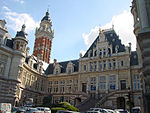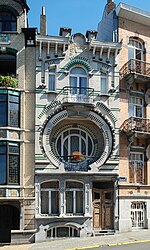Saint-Gilles, Belgium

Saint-Gilles (French, pronounced [sɛ̃ ʒil] (listen)) or Sint-Gillis (Dutch, pronounced [sɪntˈxɪlɪs] (listen)) is one of the 19 municipalities of the Brussels-Capital Region, Belgium. Located in the southern part of the region, it is bordered by the City of Brussels, Anderlecht, Forest and Ixelles. In common with all of Brussels' municipalities, it is legally bilingual (French–Dutch). Saint-Gilles has a multicultural identity stemming from its diverse population. The housing stock varies from semi-derelict tenements near Brussels-South railway station in the north, to elegant bourgeois houses on the southern borders with Uccle and Ixelles, to tourist hotels at the inner end of the Chaussée de Charleroi/Charleroisesteenweg.
Excerpt from the Wikipedia article Saint-Gilles, Belgium (License: CC BY-SA 3.0, Authors, Images).Saint-Gilles, Belgium
Avenue Brugmann - Brugmannlaan,
Geographical coordinates (GPS) Address Nearby Places Show on map
Geographical coordinates (GPS)
| Latitude | Longitude |
|---|---|
| N 50.816666666667 ° | E 4.35 ° |
Address
Avenue Brugmann - Brugmannlaan 158
1190
Belgium
Open on Google Maps






